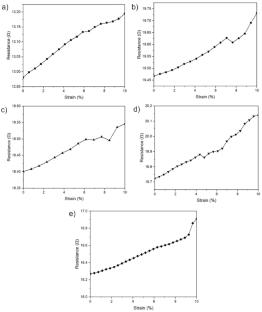基于深度学习模型的缝式纺织品传感器表征与预测
摘要
本研究调查了五种类型的缝制类型-直,之,拼接,缎面和波浪-在10以下% tensile strain to evaluate their performance as textile sensors. Only the peak resistance values were extracted from each test and used to train a bidirectional long–short-term memory (Bi-LSTM) model. Structural characteristics of each stitch were analyzed through normalized resistance changes, \(\Delta s\) values, and principal component analysis (PCA). The wave stitch showed the highest resistance change rate (0.04) and the largest \(\Delta s\) (1.5), indicating high sensitivity. The Bi-LSTM model was trained to predict these features, achieving a test RMSE of 0.70. Among all stitch types, the wave stitch yielded the lowest RMSE (0.46), demonstrating strong predictive alignment with its physical response. These results confirm the model’s reliability in capturing and predicting stitch-specific sensing characteristics. This approach offers a data-driven method for evaluating and comparing stitched textile sensors, providing insights into their design and application potential. The findings suggest that deep learning models can effectively identify and forecast sensor behavior based on structural and signal features, contributing to the future development of smart textile sensors.

This study investigates five types of stitched types—straight, zigzag, joining, satin, and wave—under 10% tensile strain to evaluate their performance as textile sensors. Only the peak resistance values were extracted from each test and used to train a bidirectional long–short-term memory (Bi-LSTM) model. Structural characteristics of each stitch were analyzed through normalized resistance changes, \(\Delta s\) values, and principal component analysis (PCA). The wave stitch showed the highest resistance change rate (0.04) and the largest \(\Delta s\) (1.5), indicating high sensitivity. The Bi-LSTM model was trained to predict these features, achieving a test RMSE of 0.70. Among all stitch types, the wave stitch yielded the lowest RMSE (0.46), demonstrating strong predictive alignment with its physical response. These results confirm the model’s reliability in capturing and predicting stitch-specific sensing characteristics. This approach offers a data-driven method for evaluating and comparing stitched textile sensors, providing insights into their design and application potential. The findings suggest that deep learning models can effectively identify and forecast sensor behavior based on structural and signal features, contributing to the future development of smart textile sensors.

 求助内容:
求助内容: 应助结果提醒方式:
应助结果提醒方式:


